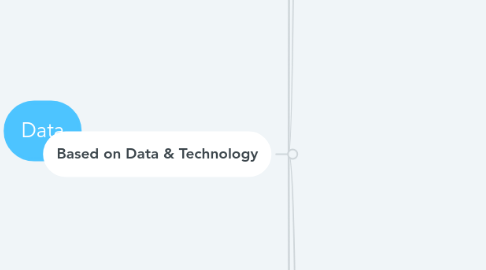
1. Based on Data & Technology
1.1. Data
1.1.1. Descriptive analysis
1.1.1.1. What happen in the past?
1.1.2. Predictive analysis
1.1.2.1. What will happen in the future?
1.1.3. Prescriptive analysis
1.1.3.1. How we can change the future?
1.2. Maps of relation
1.2.1. Basic
1.2.1.1. Technology at the center
1.2.1.1.1. Business
1.2.1.1.2. Communication
1.2.1.1.3. Artificial inteligence
1.2.2. Data
1.2.3. Data science
1.2.4. Machine Learning applied to Big Data
1.3. Concepts
1.3.1. Artificial Intelligence
1.3.1.1. Components
1.3.1.1.1. Machine Learning
1.3.1.1.2. Natural Learning Processing NLP
1.3.1.1.3. Speech
1.3.1.1.4. Expert systemas
1.3.1.1.5. Planing, schedulin and optimization
1.3.1.1.6. Robotics
1.3.1.1.7. Vision
1.3.1.2. Vens
1.3.1.2.1. 1
1.3.1.2.2. 2
1.3.1.3. Process
1.3.1.3.1. Amadeus
1.3.1.4. Analytics vs AI
1.3.1.4.1. 1
1.3.1.5. 3 stages
1.3.1.5.1. Machine learning
1.3.1.5.2. Machine intelligence
1.3.1.5.3. Machine consiousness
1.3.1.6. History
1.3.2. Data Science
1.3.2.1. Data Sciences
1.3.2.1.1. Statistics
1.3.2.1.2. Econometrics
1.3.2.1.3. Machine Learning
1.3.2.1.4. Data Mining
1.3.2.1.5. Artificial inteligence
1.3.2.1.6. Operations Research
1.3.2.1.7. Natural Language Processing
1.3.2.2. Additional Methods and techniques
1.3.2.2.1. Linear / No linear programming
1.3.2.2.2. MCMC methods
1.3.2.2.3. Latent class methods
1.3.2.2.4. Structural equation models
1.3.2.2.5. Discrete choice models
1.3.2.2.6. Dimensionality reduction
1.3.2.2.7. Hierarchical Bayes Models
1.3.2.3. Techniques
1.3.2.3.1. Linear / No linear regressions
1.3.2.3.2. Logistics regressions
1.3.2.3.3. Time-series models
1.3.2.3.4. Optimization
1.3.2.3.5. A/B testing
1.3.2.3.6. Clustering
1.3.2.3.7. Factor analysis
1.3.2.3.8. Principal component analysis
1.3.2.3.9. Neural networks
1.3.2.3.10. Support vector machines
1.3.2.3.11. Bayesian Techniques
1.3.2.3.12. Survival Analysis
1.3.2.4. Tools
1.3.2.4.1. R, SAS
1.3.2.4.2. Python, Java, C++
1.3.2.4.3. SPSS, Matlab, Minitab
1.3.2.4.4. CPLEX, GAMS, Gauss
1.3.2.4.5. Tableau, Spotfire
1.3.2.4.6. VBA, Excel
1.3.2.4.7. Javascript, Perl, PHP
1.3.2.4.8. Open Source Databases
1.3.2.4.9. MySQL
1.3.2.4.10. AWS, Cloud Solutions
1.3.2.5. Vertical applications
1.3.2.5.1. Big Data Solutions
1.3.2.5.2. Social Media Analytics
1.3.2.5.3. Online advertising
1.3.2.5.4. Display marketing
1.3.2.5.5. Text analytics
1.3.2.5.6. Retail analytics
1.3.2.5.7. Customer analytics
1.3.2.5.8. Forecasting
1.3.2.5.9. Pricing and revenue oprtimization
1.3.2.5.10. Custom insights
1.3.2.5.11. Custom reporting
1.3.2.5.12. Custom dashboard
1.3.2.6. Data adapters
1.3.2.6.1. Social Data connectors ( facebook, twitter )
1.3.2.6.2. Extract - transfer - load ETL toolset
1.3.2.7. Outreach / Hooks
1.3.2.7.1. Hooks into agent app
1.3.2.7.2. Hooks into CRM platforms
1.3.2.7.3. Hooks into mobile devices
1.3.3. Big Data Ecosystem
1.3.3.1. 1. Data Creation ( producer )
1.3.3.1.1. Machine and sensors
1.3.3.1.2. Transaction and usage logs
1.3.3.1.3. Relationships and social influence
1.3.3.1.4. Mobile apps data
1.3.3.1.5. Email & messaging
1.3.3.1.6. Goelocation
1.3.3.2. 2. data acquisition (architects & engineers)
1.3.3.2.1. Shared nothing scale-out storage + SSD
1.3.3.2.2. MPP + In-memory compute
1.3.3.2.3. Converged infrastructure
1.3.3.2.4. Non-relational DWH
1.3.3.2.5. High speed resiliency networking
1.3.3.2.6. Cloud
1.3.3.2.7. Hadoop
1.3.3.3. 3. Info processing (scientist & analyst)
1.3.3.4. 4. Business process (en user)
1.4. People
1.4.1. Data Scientist (team?)
1.4.1.1. What is?
1.4.1.1.1. Still a fuzzy concept
1.4.1.1.2. Battle of the Data Science Venn Diagrams
1.4.1.1.3. The process
1.4.1.2. Mindset
1.4.1.2.1. Scientific mindset
1.4.1.2.2. Curious
1.4.1.2.3. Creative
1.4.1.2.4. Business thinking
1.4.1.2.5. Pragmatic
1.4.1.3. Skills
1.4.1.3.1. Computer science
1.4.1.3.2. Analytics
1.4.1.3.3. Data Management
1.4.1.3.4. Art & Design
1.4.1.3.5. Entrepreneurship
1.4.1.4. Educational background
1.4.1.5. Steps to become Data Scientis
1.4.1.5.1. Step 1. Get Good at Stats, Maths and Machine Learning
1.4.1.5.2. Step 2. Learn to Code
1.4.1.5.3. Step 3. Understand Databases
1.4.1.5.4. Step 4. Explore the data science workflow
1.4.1.5.5. Step 5. Level up with big data
1.4.1.5.6. Step 6. Grow, connect and learn
1.4.1.5.7. Step7. Immerse yourself completely
1.4.1.5.8. Step 8. Engage with community
1.4.1.6. Profile
1.4.1.6.1. Woman
1.4.1.6.2. Man
1.4.1.7. Data Science learning plan for 2017
1.4.1.8. www.analyticsvidhya.com
1.4.1.8.1. Data Science learning plan for 2017
1.4.1.8.2. Glossary
1.4.1.8.3. Simple Beginner’s guide
1.4.1.8.4. Infographics
1.4.1.8.5. A Step-by-Step Guide to learn Advanced Tableau
1.4.1.8.6. Learning plan for beginners
1.4.1.8.7. Learning Plan 2017 for Transitioners
1.4.1.8.8. Learning Plan 2017 for Intermediates
1.4.1.8.9. Data Scientist vs Data Engineer vs Statistician
1.4.1.8.10. Job Roles in Data Science Industry
1.4.1.8.11. Hackathons
1.5. Google trends
1.5.1. Last years
1.6. Process
1.6.1. 1
